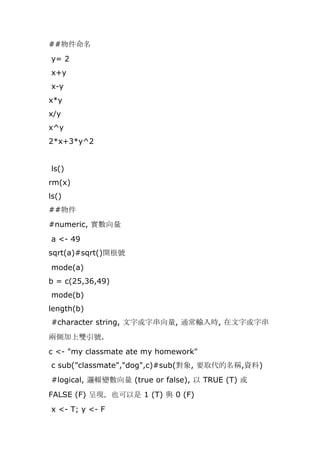
R code 1
- 1. ##物件命名 y= 2 x+y x-y x*y x/y x^y 2*x+3*y^2 ls() rm(x) ls() ##物件 #numeric, 實數向量 a <- 49 sqrt(a)#sqrt()開根號 mode(a) b = c(25,36,49) mode(b) length(b) #character string, 文字或字串向量, 通常輸入時, 在文字或字串 兩側加上雙引號. c <- "my classmate ate my homework" c sub("classmate","dog",c)#sub(對象, 要取代的名稱,資料) #logical, 邏輯變數向量 (true or false), 以 TRUE (T) 或 FALSE (F) 呈現,也可以是 1 (T) 與 0 (F) x <- T; y <- F
- 2. z = c(x, y) z b b>30 larger.than.30 = b>30 rbind(b, larger.than.30)#row(列),橫著排 cbind(b, larger.than.30)#column(欄),縱著排 #dataframe, 資料欄(長度要相同) data.frame(b, larger.than.30) mydata = data.frame(b, larger.than.30);mydata#使用;在 同一行中執行多個完整的指令 mydata[1,]#顯示第一列 mydata[,2]#顯示第二欄 #使用$(錢字號)指定資料欄中的元件) mydata$b mydata$larger.than.30 #使用 attach 綁定資料欄 CO2#R 內建的資料 CO2$uptake CO2$conc uptake attach(CO2) uptake conc test ##讀取資料 #使用 scan()
- 3. x1 = scan() x2 = scan() scan.failed = scan() getwd()#查詢目前的工作路徑 read.table("random.csv") read.table("random.csv",header = TRUE, sep = ",") random = read.table(file.choose(), header = TRUE, sep = ",") str(random) random random[9,] random$x random$y random$x3#如未填入資料,則 R 讀取資料時會填入 NA ##缺失值 NA, NaN, 與 Null #NA “not available” x <- c(1, 2, 3, NA) x+3 #非數字 “Not a number” log(c(0, 1, 2)) 0/0#infinity Inf - Inf pi / 0 ## = Inf a non-zero number divided by zero creates infinity 0 / 0 ## = NaN 1/0 + 1/0 # Inf 1/0 - 1/0 # NaN #null,物件的長度為 0 z = c()
- 4. z #任何含有 NA 資料的運算結果都將是 NA 1+NA max(c(NA, 4, 7)) max(c(NA, 4, 7), na.rm=T)#na.rm,移除缺失值 #回到 random.csv 資料來看 max(random$x3) max(random$x3,na.rm=T) mean(random$x3) mean(random$x3,na.rm=T) edit(random)#手動編輯資料,進行一些小修改時很有用 random random.modified = edit(random) fix(random)#直接修改資料 random #封面的兔子 require(onion) data(bunny) p3d(bunny,theta=3,phi=104,box=FALSE)
